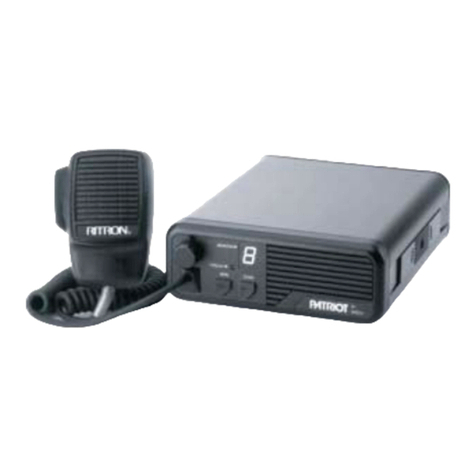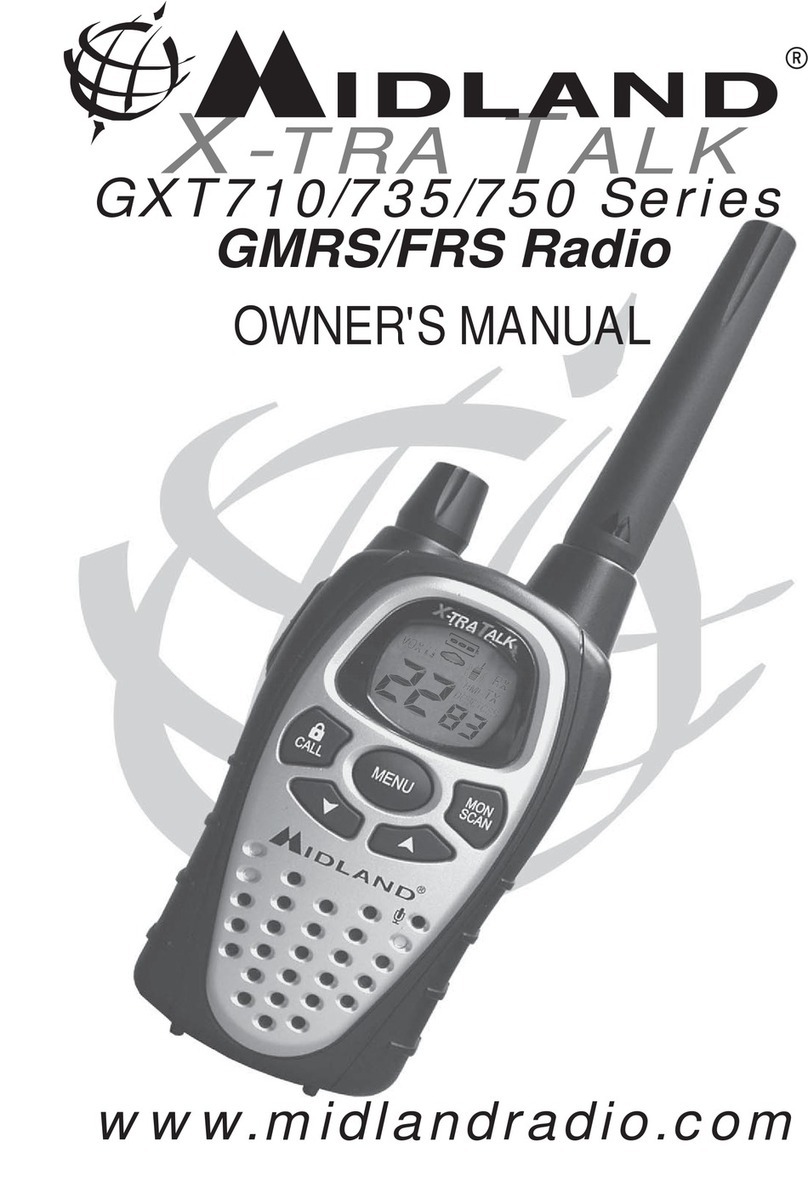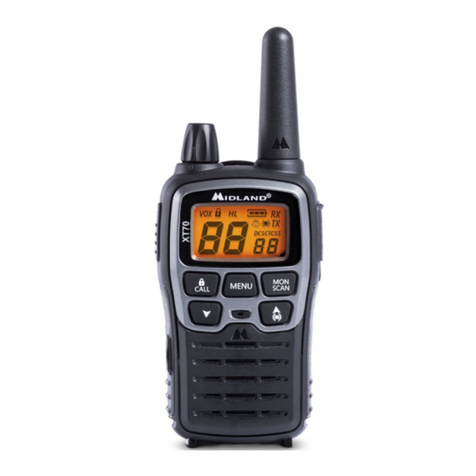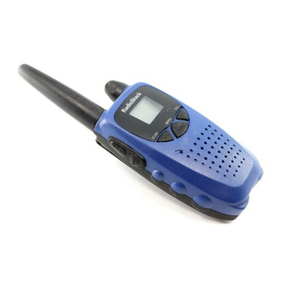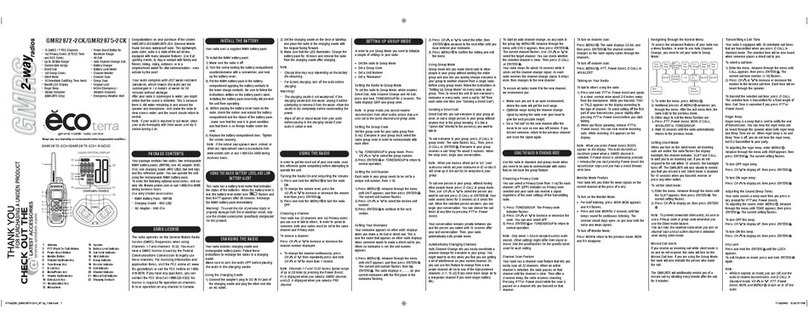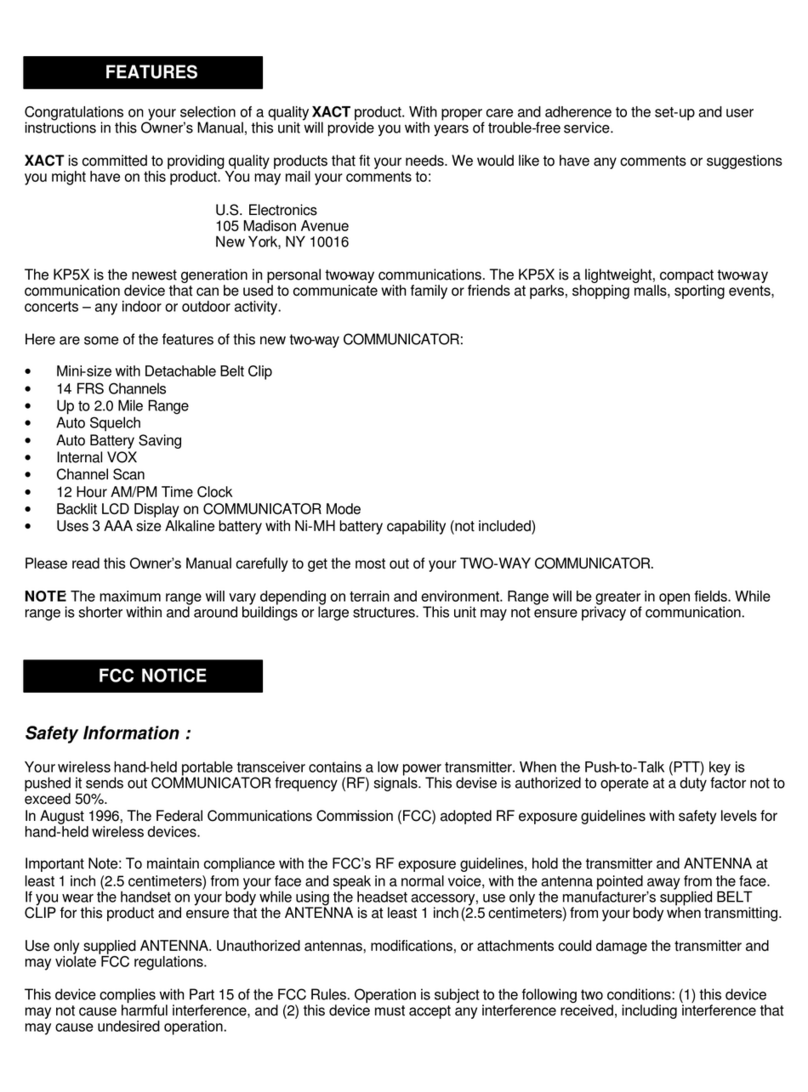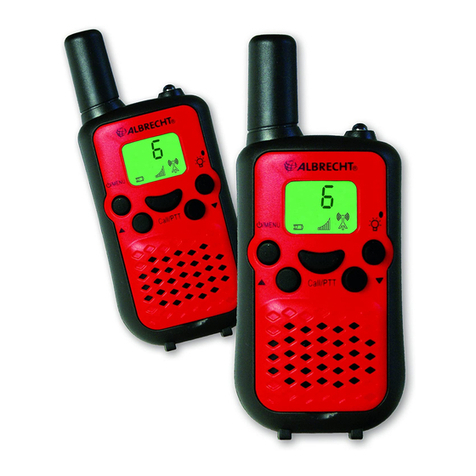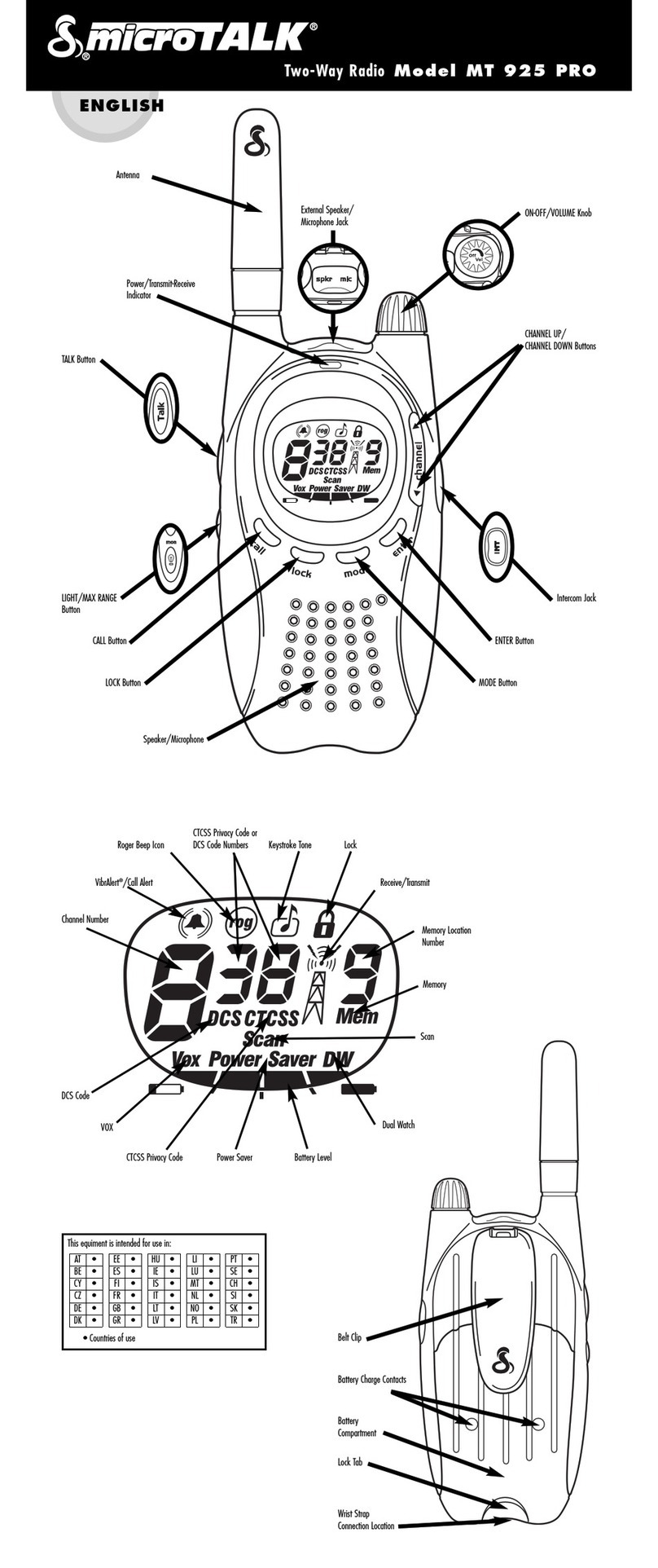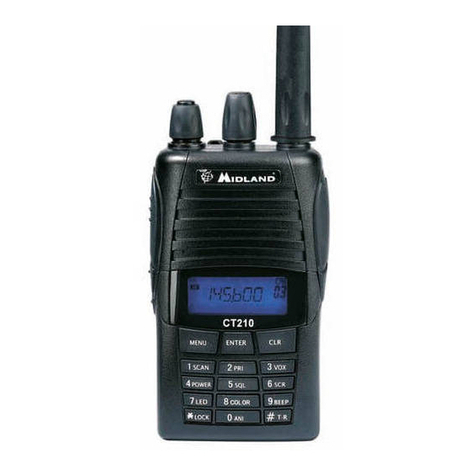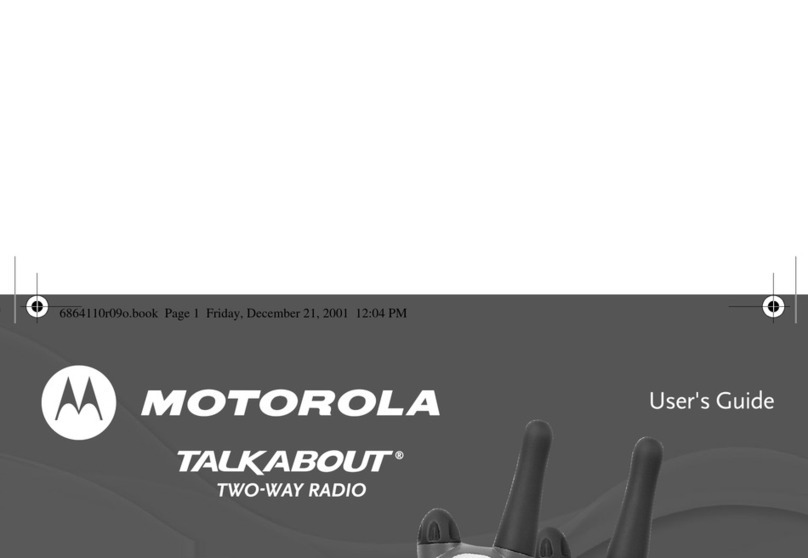Patriot SST-144D User manual

Have questions? Call
800-USA-1-USA
(800-872-1872) or visit our website at www.ritron.com
PATRIOT
®
SST DISPLAY SERIES
OWNER'S MANUAL
Up to 10 Channel Capability
Easier Enhanced Programming Method
2, 3, and 4 Watt Models
Quic -change Battery
Drop-in Charge Capable
Weather Channel Feature (VHF only)
Emergency Weather Alert Feature (VHF only)
Channel Scan (Normal or Priority)
Loud Easy-To-Hear High Audio Output
Built-in Quiet
Call®
Interference Eliminator
Digital Quiet
Call®
Interference Eliminator
2-Tone Paging Encode and Decode
DISPLAY SERIES HANDHELDS
COMPACT, ULTRA-SMALL
PROFESSIONAL TWO-WAY RADIOS
NOW
with
ENHANCED
Feature List

ACCESSORIES
ii
OPTIONAL ACCESSORIES:
TO ORDER, CALL 800-USA-1-USA
BPJS-6N .......... Spare/ Replacement JMX Battery
BPS-6N-SC ...... Spare/ Replacement SST Battery
BPS-6N-MH ..... Replacement High Capacity Battery
AFS- 50 ........... VHF Molded Flex Antenna
AFS-450 ........... UHF Molded Flex Antenna
RHD- X ............ Single Ear Headset
RHD-4X ............ Dual Ear Headset
RHD-5X ............ Lightweight Over-the-ear Earset /w In-line PTT
RHD-6X ............ Lightweight Behind-the-head Earset w/ In-line PTT
RSM-3X ........... Remote Speaker Microphone
REP-2 ............... Low Profile Earphone
CCL-B ............. Cigarette Lighter Charger
MHC-A ............ Cordura Holster w/beltclip & neckstrap
BCJS-4AD ...... 4-Well Drop-in Charger: JMX
BCPS-4AD ...... 4-Well Drop-in Charger: SST
BCPS-AD ......... Single-Well Drop-in Charger: SST (Overnight)
BCC-PS ........... Drop-in High-rate Charger/
Conditioner; for SST Models only
Call RITRON for complete listings.
RHD-1X
Single Ear Headset
RHD-4X
Dual Ear Headset
RSM-3X
Remote Speaker Mic
The NEW "D-Series" models contain updated programming features, and program differently than other SST
portables. These radios provide more channels, allo you to change channel programming contents individually,
and also allo you to delete one or more channels, and add it back in, if needed.
RHD-5X
Over the ear Earset
RHD-6X
Behind the ear Earset
BCPS-4AD
4 Well Drop in Charger
BCPS-AD
Single Well Drop in Charger
MHC-A
Cordura Holster
BPS-6N-SC
Spare Battery
Have questions? Call
800-USA-1-USA
(800-872-1872) or visit our website at www.ritron.com

Have questions? Call
800-USA-1-USA
(800-872-1872) or visit our website at www.ritron.com
DESCRIPTION PAGE
BATTERIES
FIG-8: Battery Access and Installation ........................................................... 11
Optional Charging Accessories ........................................................................ 11
Charging ............................................................................................................ 12
Battery Maintenance and Conditioning ......................................................... 12
!! CAUTIONS ALL RADIOS !!
Obser e Caution in the Following En ironments to Maximize the Life of
Your Radio Equipment ..................................................................................... 13
Exposure to Radio Frequency Energy ............................................................ 1 3
TROUBLESHOOTING
Notes .................................................................................................................. 14
Chart ................................................................................................................... 14
FCC LICENSE REQUIRED
FCC Regulations ............................................................................................... 1 5
Ser ice ............................................................................................................... 1 5
How to Obtain an FCC Radio License ............................................................ 15
LIMITED WARRANTY .......................................................... INSIDE BACK COVER
RITRON WIRELESS SOLUTIONS .................................................... BACK COVER
TABLE OF CONTENTS
DESCRIPTION PAGE
ACCESSORIES
Optional Accessories ......................................................................................... i i
INTRODUCTION
SST "D-Series" Model Numbers ...................................................................... 1
Features.............................................................................................................. 1
CONTROL & OPERATION ..................................................................................... 2
FIG-1: Radio Controls and Connectors .......................................................... 2
OPERATION
On-off/ Volume Adjust ....................................................................................... 3
Selecting Channels ........................................................................................... 3
Recei ing Calls ................................................................................................. 3
QC and DQC Tone Codes (Interference Eliminator Codes) .......................... 3
FIG-2: Setting Squelch Mode ......................................................................... 4
FIG-3: Transmit / Busy Lamp .......................................................................... 4
Making Calls (Transmit) .................................................................................... 4
Radio Alert Tones ............................................................................................. 4
Optional Alert Tones ......................................................................................... 5
Scan Channel Operation .................................................................................. 5
Recei e 2-Tone Page ....................................................................................... 6
Send 2-Tone Page ............................................................................................ 6
FIG-4: Reset 2-Tone Paging ........................................................................... 6
NOTES .................................................................................................................... 7
NOAA WEATHER RADIO
How to Preset Your Radio for Local NOAA Weather Broadcasts .................. 8
FIG-5: Presetting Your Local NOAA Weather Broadcasts ............................ 8
FIG-6: NOAA Frequencies ............................................................................... 8
NOAA Weather Channel ................................................................................... 8
Weather Alert ..................................................................................................... 8
RADIO PROGRAMMING
FIG-7: How To Place the Radio in Program / Readout Mode ..................... 9
How to Readout the Radio Identification Code / Placing
the radio in Programming Mode ..................................................................... 9
Channel Scan: How to Turn "ON / OFF" ......................................................... 9
Weather Channel: How to Turn "ON / OFF" ................................................. 1 0
Weather Alert: How to Turn "ON / OFF" ........................................................ 1 0
PC Programmable Features ........................................................................... 1 0
Call RITRON at
800-USA-1-USA
(800-872-1872) or a complete Accessory listing or visit our website at www.ritron.com
INSPECTION
Make sure the package includes:
SST "D-Series" radio
Antenna
Rechargeable battery pack (installed in radio)
elt clip
Owner's Manual
Examine the equipment immediately after delivery and report any
damage to your shipping company.
NOTE: Refer to pages ii and 11 for Accessory information

page 3 RITRON, INC. 1-800-USA-1-USA
(1-800-872-1872)
Have questions? Call
800-USA-1-USA
(800-872-1872) or visit our website at www.ritron.com
INTRODUCTION
page 1
THANK YOU FOR CHOOSING RITRON
Congratulations on your purchase of the SST "D-Series"
radio. Your new radio is the culmination of Ritron's 2
years of designing, manufacturing, and supplying reliable,
professional wireless communication products. Ritron
wireless products will improve the operation, safety, and
profitability of any organization by providing instant voice
communications between employees throughout the
workplace.
SST "D-SERIES" MODEL NUMBERS
VHF MODELS
SST-144D ...... (Patriot) ..... (4-Watt, 10 Channel)
UHF MODELS
SST-446D ...... (Patriot) ..... (2-Watt, 10 Channel)
SST-444D ...... (Patriot) ..... (3-Watt, 10 Channel)
The model number located on the back of the radio
case indicates its operating band.
VHF radios are designed to operate on up to ten
channels within the 12 MHz band between factory
standard 1 0 and 162 MHz.
UHF radios are designed to operate on up to ten
channels within the 20 MHz band between factory
standard 4 0 and 470 MHz.
FEATURES
This manual covers the Ritron SST "D-Series" radios.
These radios are compact, programmable two-way
handhelds designed to operate in a professional FM
communications band (VHF or UHF business available).
Each radio is equipped with these features:
Push-button operating ontrols. The Push-To-
Talk (PTT) and Channel buttons are on one side of
the radio, and the On/ Volume Up, Volume Down/
Off and monitor controls on the top.
Channel display. The LED display will show the
current operating channel,and contains a transmit/
busy lamp. The display also indicates paging
decode status on radios programmed for 2-tone
paging operation.
Qui k- hange battery pa k and drop-in
harger apabilities. See Optional Charging
Accessories on the page 11.
10- hannel apability. Up to 10 channels can be
programmed to contain a unique set of operating
frequencies and options.
QC (Quiet Call) and DQC (Digital Quiet Call)
intereferen e eliminator odes. Each channel
can be programmed from a list of 1 QC sub-
audible codes or 83 DQC digital privacy codes.
2-tone paging de ode. Each channel can be
programmed for 2-tone paging decode within a
frequency range of 300-1 00 Hz. Additional 2-tone
paging features include Group Call, All Call,
automatic reset, and transpond alert.
2-tone paging en ode. Each channel can be
programmed for 2-tone paging encode within a
frequency range of 300-1 00 Hz.
Wide or narrow band operation. Each channel
is programmable for wide or narrow band transmit
operation.
High or low transmit power. Each channel can
be programmed for high or low transmit power to
satisfy your needs for extended range or battery
conservation. (This option is not available on the
SST-446D)
Channel s anning. The Scan channel allows
scanning of all channels programmed into the
radio, and can be turned On and Off through Field
programming. The scan channel has many
features, including Priority Scanning and Busy
Channel Blocking.
Weather Channel. VHF models can be pro-
grammed to receive your local NOAA weather
radio broadcast. The Weather channel can be
turned On and Off through Field programming.
Weather Alert. VHF models can be programmed
to alert you when the National Weather Service
detects threatening weather conditions. The
Weather Alert feature can be turned On and Off
through Field programming.
Low battery alert. The SST "D-Series" radio will
sound a series of low battery alert tones when
your battery is running down to allow you time to
recharge or change your battery.
Alert tones. Each channel is programmable for a
variety of alert tones that include RX courtesy
beep, TX clear to talk beep, busy channel lockout
alert, last active channel marker, and channel
scanning indicator.
Squel h adjustment. Squelch sensitivity can be
programmed on a per channel basis to meet your
specific needs.

Have questions? Call
800-USA-1-USA
(800-872-1872) or visit our website at www.ritron.com
CONTROL & OPERATION
IMPORTANT: CHARGE THE BATTERY PACK before using the radio for the first ti e. Refer to Batteries, pages 11 and 12.
page 2
1ANTENNA
The flexible antenna radiates and receives radio signals.
Screw the antenna base all the way into the threaded
bushing on top of the radio.
NOTE: Use only the type of antenna furnished with
the radio. VHF and UHF antennas are not
interchangeable.
2ON/ VOLUME UP
To switch the unit On, press the On/ Volume Up button;
the speaker will emit a turn on beep. If the radio turns
on to the Scan Channel it will emit the Resume Scan
Beep. Once the radio is On, press this button to
increase volume.
3VOLUME DOWN/ OFF
Press the Volume Down/ Off button to decrease
volume. To switch Off the unit, press and hold this
button until the speaker emits a double beep.
4PUSH-TO-TALK SWITCH (PTT)
Press and hold the PTT when transmitting; release it to
receive.
5CHANNEL SELECTOR
Press the button and the radio will emit the channel
beep, advance the channel, and the channel display will
show the new operating channel. When the Scan
Channel is selected the radio will emit the Resume Scan
Beep and the radio will begin scanning.
6BATTERY ACCESS DOOR
(CASE BOTTOM)
The battery access door may be removed to access
the battery pack. Refer to Battery Access & Installation,
FIG-8, page 11.
7JACK COVER
This rubber cover seals out dust and moisture, etc.
Snap the cover into the audio accessory jack and
charge jack openings when the jacks are not in use.
8AUDIO ACCESSORY JACK
The audio accessory jack is used to plug in earphone
options, and, in conjunction with the charge jack, to
connect an optional remote speaker/ microphone or a
single- or dual-ear headset. This jack is also used for
PC programming.
9CHARGE JACK
The battery pack may be charged through this jack
using the RITRON charger cube. Refer to Accessories,
page ii, for additional charging options.
10 CHANNEL DISPLAY
The channel display will indicate the current operating
channel. When the Scan Channel is selected the
display will rapidly flash the channels being scanned,
and will stop when a channel is received.
11 SPEAKER
The speaker, located behind the front grille, allows you
to hear calls on your channel.
12 MICROPHONE
The microphone allows your voice to be heard in
transmissions to other radios. Speak in a normal tone;
shouting does not improve your listener's reception.
13 DROP-IN CHARGING CAPABILITY
Two contacts, in the bottom of the radio, permit
charging the battery pack with an optional drop-in
charger. Refer to Optional Charging Accessories,
page 11.
CH
ON OFF/HOLD
VOLUME
FIG-1: RADIO CONTROLS & CONNECTORS
1
2
3
4
5
6
7
8
9
11
12
13
10

page 3 RITRON, INC. 1-800-USA-1-USA
(1-800-872-1872)
Have questions? Call
800-USA-1-USA
(800-872-1872) or visit our website at www.ritron.com
OPERATION
page 3
ON-OFF / VOLUME ADJUST
To turn on the radio - press the On/Volume Up button.
The radio will emit the Channel beep. If the radio turns on
to the Scan Channel it will emit the Scan Beep. The radio
will turn on to the channel that was selected when it
was last turned off, or can be pro rammed to always
turn on to channel 1.
To adjust the volume - press the volume up or the volume
down button until you reach the desired level. You
should hear noise or any broadcasts on the channel.
To turn off the radio - press and hold the Off/Volume
Down button until a two tone "turn-off" beep is heard.
For instant turn-off, press the PTT button while holdin
the Off/Volume Down button.
SELECTING CHANNELS
To chan e channels - press and release the Channel
Selector button. The radio will emit a short Channel beep,
increment the channel, and the Channel Display will
show the new operatin channel. If the hi hest channel
number is selected and you press the Channel Selector
button, the radio resets to channel 1 and the Channel
beep is heard on the speaker.
If the Scan Channel is selected - the radio will emit the
Scan Beep and the Channel Display will rapidly flash the
channel numbers as they are scanned. If a si nal is
received the channel display will indicate the channel
number, and when the received si nal is removed the
radio will wait briefly, sound the Scan Beep, then
scannin will resume as normal.
If the Weather Channel is selected - on a VHF radio the
Channel beep will be heard and the display will li ht a
sin le se ment that indicates which of the seven NOAA
frequencies is monitored. See the "NOAA Weather
Radio" section on pa e 8 for details.
RECEIVING CALLS
To hear calls from other users - adjust the volume as
desired. The radio can receive broadcasts while the
Push-To-Talk button is not bein pressed. Whether or
not you hear these broadcasts depends upon the
squelch settin s.
There are four squelch modes that can be used in the
SST "D-Series" portable.
Carrier squelch lets you hear all broadcasts on
your channel stron enou h for the radio to detect,
and silences noise.
Tone squelch uses one of the QC or DQC tone
squelch formats available on the SST. This allows
you to screen out on-channel broadcasts that do
not carry the correct code pro rammed for the
radio.
No squelch disables all squelch operation and
allows you to hear even the weakest broadcasts
on your channel.
2-tone paging can be used in conjunction with
either carrier or tone squelch to block out all calls
except those sent specifically to your radio. When
the unique 2-tone sequence pro rammed into the
radio is decoded, the radio will emit a series of rin
tones similar to a telephone.
If Carrier or Tone Squelch has been selected by the
user, all channels will operate in that mode. The SST
"D-Series" radio will operate in tone squelch mode
when it is 1st turned on.
To monitor the channel - press one of the volume
control buttons. When you press the volume up or the
volume down button, squelch turns off and all radio
traffic on the channel (or noise) sounds in the
speaker.
To activate carrier squelch - simultaneously press
both of the volume buttons and hold briefly before
releasin . When carrier squelch is on, the radio emits
a double beep. The radio will now let you hear all
broadcasts on your channel.
To activate tone squelch - simultaneously press both
of the volume buttons and hold briefly before
releasin . When tone squelch is turned on, the
handheld sounds one beep. You will only hear
broadcasts that carry the same QC or DQC code
pro rammed into your radio.
To activate no squelch - simultaneously press both of
the volume buttons and continue to hold them down.
About 3 seconds after the beep (or double beep), the
radio will start beepin repeatedly. This means that
squelch is turned off. Release the buttons. To restore
squelch, press and hold both of the volume buttons
until the radio sounds a beep or double beep.
If you are unable to activate carrier or no squelch the
radio has been optionally pro rammin for Monitor
Lockout. See your Ritron dealer or contact Ritron
directly to disable this option.
QC AND DQC TONE CODES
(Interference Eliminator Co es)
Tone co es filter out static, noise an re uce
unwante "chatter" on ra io channels. When
you operate on a frequency with a tone co e,
you screen out most interference. This allows
you to communicate with less interference an
to hear only those users in your ra io group.
IMPORTANT! All ra ios in the talk group
must operate on the same
frequency an tone co e.

Have questions? Call
800-USA-1-USA
(800-872-1872) or visit our website at www.ritron.com
page 4
To activate 2-tone pa in - simultaneously press both of
the volume buttons and hold briefly before releasin .
When 2-tone pa in is turned on, the handheld sounds a
"triple beep". You will only hear broadcasts that first
send your two unique pa in tone.
Note: It is possible that the be innin of a call mi ht be
missed while the radio is in battery saver mode. If this
happens, ask the caller to repeat the messa e.
OPERATION
the channel prior to transmittin .
To transmit - hold down the Push-To-Talk button and
with the radio four inches away talk into the
microphone. Speak in a normal tone, since talkin
louder will not improve the listeners reception.
Keep talk times as short and infrequent as possible to
conserve battery, minimize radio frequency exposure,
and allow others to use the channel.
RADIO ALERT TONES
The handheld responds to certain instructions by
soundin a beep or series of tones. These tones can
tell you that the radio is workin as you expect.
Power On/Self Check OK
When it is first turned on, the radio runs a quick
self test to confirm basic functions. When
complete the radio will emit the channel beep and
the Channel Display will show the operatin
channel. The radio is then ready to use.
Channel Scan Tone
When the Scan channel is selected by pressin the
Channel button, the radio will emit the Scan beep
and be in scannin .
Squelch Mo e Tones
When you press and hold both Volume buttons at
the same time, a sin le beep will sound to indicate
that tone squelch is on. A double beep means that
carrier squelch is on. If the channel is pro rammed
for 2-tone pa in , a "triple beep" indicate that the
pa er has been reset.
Transmitter Time Out Tone
A low tone followed by a hi her-pitched tone
sounds and the transmitter automatically shuts off if
you hold down the PTT button lon er than 60 sec-
onds. The radio automatically switches to receive
mode.
Recharge Battery Alert Tone
As the battery volta e approaches the minimum
required operatin volta e the radio will emit a
series of low battery tones to alert the user that the
battery will soon need rechar in . Once the battery
char e drops below the required operatin
volta e, the radio emits a lon , low tone and turns
itself off. If you turn the radio back on, it will beep
a ain and shut itself off. Rechar e the battery.
Error Tones
If the self test detects a dia nostic error, an error
tone sounds. The error tone indicates the radio
frequency synthesizer is malfunctionin . Turn off
the radio and try a ain.The error tone will also
sound if a channel has been pro rammed for an
invalid frequency. A lon , low-pitched tone means
the battery volta e is too low to operate the radio.
In this case, rechar e the battery. If you cannot
correct a problem, consult an authorized Ritron
service facility or Ritron.
FIG-3: TRANSMIT/BUSY LAMP
A Transmit / Busy
Lamp in the upper left
corner of the
Channel Display is lit
whenever the
transmitter is
activated and blinks
when the channel is
busy.
CH
ON OFF/HOLD
VOLUME
FIG-2: SETTING SQUELCH MODE
To chan e squelch mode simultaneously press both
of the volume buttons.
MAKING CALLS (TRANSMIT)
Normally, you should not transmit until no one is talkin
on the channel. This can be determined by monitorin

page 3 RITRON, INC. 1-800-USA-1-USA
(1-800-872-1872)
Have questions? Call
800-USA-1-USA
(800-872-1872) or visit our website at www.ritron.com
OPERATION
When receivin a call on a channel bein scanned, the
radio will stop scannin to let you hear communica-
tions on that channel. After the transmission has
ended the radio will pause before it resumes scannin
to allow you time to respond.
When transmittin from the Scan Channel, the
handheld will o to the last channel on which a si nal
was received, then transmit. After you release the
PTT the radio will pause to allow time for a response,
and then resume scannin .
Temporary Busy Channel Blocking
If one of the channels in the scan list is so busy that
you want to temporarily block it out, press the Channel
Selector button while the radio is stopped on the
channel to be blocked and hold it until scannin
resumes. The blocked channel will now be skipped in
the scan list.
The blocked channel will be returned to the scan list if
the radio is turned off, or when the radio channel is
chan ed usin the Channel Selector button. The 1st
channel in the scan list cannot be blocked.
Last Channel Scanned Alert Tone
When chan in channels with the Channel Selector
button, an alert tone will sound to indicate the last
channel that received a messa e when the radio was
scannin . This will identify the channel on which the
last messa e was received, and allow uninterrupted
transmission on that channel without the constraints
of scannin . You can then press the Channel Selector
button to return to the scan channel.
page 5
OPTIONAL ALERT TONES
The SST "D-Series" radio can be pro rammed usin
the RITRON PC Pro rammer for optional alert tones.
See your Ritron dealer or contact Ritron directly for
pro rammin of these options.
Courtesy Beep
A short tone sounds at the end of each received
transmission to indicate that the channel is clear and
you may transmit.
Busy Channel TX Inhibit Tone
If a user is transmittin on your radio frequency
without your tone, you will not be allowed to
transmit. The radio will beep a series of lon , low
tones while the PTT is held down (like a busy
si nal).
Transmit Clear To Talk Beep
A short tone sounds after the PTT has been
pressed to indicate that the radio is ready for you to
be in talkin .
SCAN CHANNEL OPERATION
Channel scannin allows you to listen to broadcasts
on your radio channels. The SST "D-Series" will scan
all channels pro rammed into the radio except the
NOAA Weather Channel.
How Scanning Works
Usin the Channel Selector button, select the Scan
Channel. The radio sounds the Scan Beep, and then
repeatedly checks each channel in the scan list. The
channel display will show the channel numbers as
they are scanned.
riority Scanning (Optional)
The SST "D-Series" radios can be optionally
pro rammed for priority scannin . Priority
Scan allows you to periodically monitor a
Priority Channel, even if the radio has stopped
on another channel. This will prevent missed
calls on the primary operatin channel when in
scan mode.
With Priority Scan enabled:
The first channel in the scan list is the
Priority Channel.
The radio checks the Priority Channel every
two seconds to check for activity. This time
is pro rammable and can be set for 1 - 8
seconds.
The radio can be pro rammed to transmit
only on the Priority Channel when scannin .
The radio can be pro rammed to sound a
Priority Channel Beep whenever the radio
receives on the Priority Channel when
scannin .
See your Ritron dealer or contact Ritron directly
for PC pro rammin of this option.
See "How to Turn Channel Scan On / Off" on
page 9.

Have questions? Call
800-USA-1-USA
(800-872-1872) or visit our website at www.ritron.com
page 6
RECEIVE 2-TONE PAGE
To use 2-tone paging the SST "D-Series"
radio must be PC programmed for this
option, the radio does not operate with 2-tone
decodin as it is received from the factory. See
your Ritron dealer or contact Ritron directly for PC
pro rammin of this option.
To activate 2-tone pa in you must first select a
radio channel that has been PC pro rammed for
2-tone pa in decode. The radio is normally
pro rammed to automatically activate 2-tone
decode any time the pa in channel is selected.
If not, simultaneously press both of the volume
buttons and hold briefly before releasin . The
handheld sounds three beeps when 2-tone
pa in is turned on. If you are unable to set the
radio, you have selected a channel that is not
pro rammed for 2-tone pa in decode.
When receivin a 2-tone pa e the radio will emit a
"rin " tone similar to a telephone and
the display will show a "C" to
indicate that a call has been
received. You can now proceed
with normal two way communication
until 2-tone pa in has been reset.
The "rin " tone will sound every time
a 2-tone pa e is decoded.
To reset 2-tone pa in after receivin a call,
simultaneously press both of the volume buttons
and hold briefly before releasin . The handheld
sounds three beeps when 2-tone pa in is reset
and the display will show the channel number.
The radio can be optionally pro rammed to
automatically reset if a call is not answered
within 15 seconds.
2-tone pa in channels can be optionally
pro rammed to:
Automatically set the radio for 2-tone pa in
mode whenever the channel is selected.
Automatically reset if a 2-tone pa e is not
answered within 15 seconds.
Automatically place the receiver into carrier
squelch "monitor" mode whenever a 2-tone
pa e has been decoded.
Transmit a transpond tone to let the pa in
station know that the pa e has been received.
Decode an All Call tone.
Decode a Group Call if the 1st tone is sent for
an extended period of time.
SEND 2-TONE PAGE
To use 2-tone paging the SST "D-Series"
radio must be PC programmed for this
option, the radio does not operate with 2-tone
encodin as it is received from the factory. See
your Ritron dealer or contact Ritron directly for PC
pro rammin of this option.
To send a 2-tone pa e you must first select a
radio channel that has been PC pro rammed for
2-tone pa in encode. Once the channel has
been selected, press and hold the Channel
button. After 2 seconds the radio will send the
2-tone pa e and the tones will be heard on the
speaker. Release the Channel button and proceed
with normal 2-way communications.
If you are unable to send a 2-tone pa e, you have
selected a channel that is not pro rammed for
2-tone pa in encode.
CH
ON OFF/HOLD
VOLUME
FIG-4: RESET 2-TONE PAGING
To reset 2-tone paging after receiving a call,
simultaneously press both of the volume
buttons and release. 2-Tone paging is reset
when the radio sounds three beeps.
OPERATION

page 3 RITRON, INC. 1-800-USA-1-USA
(1-800-872-1872)
Have questions? Call
800-USA-1-USA
(800-872-1872) or visit our website at www.ritron.com
NOTES
page 7

Have questions? Call
800-USA-1-USA
(800-872-1872) or visit our website at www.ritron.com
NOAA WEATHER RADIO
FIG-5: PRESETTING YOUR LOCAL NOAA
WEATHER BROADCASTS
CH
ON OFF/HOLD
VOLUME
1. PRESS & HOLD UNTIL
THE "RADIO OFF"
TONES ARE HEARD,
THEN RELEASE.
3. PRESS & RELEASE -
THE RADIO WILL
START BEEPING.
2. PRESS & HOLD
THE CHANNEL
BUTTON.
4. CONTINUE HOLDING THE
CHANNEL BUTTON UNTIL THE
BEEPING STOPS, THEN RELEASE
IT & LISTEN.
5. TO FIND THE NEXT ACTIVE
WEATHER CHANNEL, PRESS &
RELEASE THE CHANNEL
BUTTON.
page 8
NOAA WEATHER CHANNEL
Once a NOAA weather frequency has been selected
on your HF model radio, a channel is created for
listening to National Weather Service broadcasts.
Press the Channel button to step through your radio
channels. The NOAA Weather Channel will be after
your last channel, and the display will light the segment
representing the selected NOAA frequency.
If you do not desire a NOAA Weather Channel, it can
be turned off through Field Programming.
WEATHER ALERT
Once a NOAA weather frequency has been selected
on your HF model radio it will listen for emergency
broadcasts from the National Weather Service,
regardless of which channel you are on.
An alert tone will sound in the speaker, the
display will show an "A" (as shown), and
the National Weather Service emergency
broadcast will be heard - advising you of
threatening weather conditions. Pressing
the Channel button will return you to your
normal operating channel.
If you do not desire Weather Alert, it can be turned off
through Field Programming.
FIG-6: NOAA FREQUENCIES
162.450 MHz
162.425 MHz
162.550 MHz
162.525 MHz
162.500 MHz
162.475 MHz
HOW TO PRESET YOUR RADIO FOR LOCAL
NOAA WEATHER BROADCASTS
(VHF MODELS ONLY)
HF models of the SST "D-Series" radio can hear
weather forecasts from the National Weather Service
which are broadcast on one of the seven NOAA
weather frequencies. In some areas you may be able
to receive more than one broadcast.
The radio is shipped from the factory without a NOAA
frequency selected. Before using any of the NOAA
weather features on your HF radio you must first
select the local NOAA frequency.
1. Follow the steps in FIG-5 at right to place the
radio into the Weather Frequency Select mode.
2. The radio will scan to the 1st NOAA frequency
where a broadcast is present. The display will
light a single segment to indicate the NOAA
frequency per FIG-6.
3. Monitor the channel for a few minutes to be
sure it is the broadcast for your local area.
4. Press the Channel button to scan for the
presence of any other NOAA broadcasts,
monitoring each broadcast and noting the
frequency as indicated by the display.
5. Using the Channel button, select the local NOAA
frequency you would like your radio to operate
on.
6. Turn the radio off by pressing the olume
Down/Off button.
7. When the radio is turned back on all weather
features will operate on the selected NOAA
frequency.
NOTE: If you move to another location within your
area, or to another state, you must "re-train"
your radio with the local NOAA frequency.
162.400 MHz (center)
See "How to Turn Weather Channel On /
Off" on page 10.
See "How to Turn Weather Alert On / Off"
on page 10.

page 3 RITRON, INC. 1-800-USA-1-USA
(1-800-872-1872)
Have questions? Call
800-USA-1-USA
(800-872-1872) or visit our website at www.ritron.com
RADIO PROGRAMMING
CHANNEL SCAN: HOW TO TURN ON/ OFF
1. Follow the instructions in FIG-7 at left to place the radio in the Program/ Readout Mode.
2. he radio will display the Radio Identification code, then emit a triple beep indicating that the radio is in
program mode.
3. Using the P (push-to-talk) button and the LED display, enter a single digit code "1" to turn channel scan
on, or code "2" to turn channel scan off.
4. Pausethe display will change and show a hyphen, you will also hear a short low tone.
5. Press and release the On/ Volume Up to SAVE your programming entry. he radio will sound a triple beep
to indicate that programming was successful.
6. urn the radio OFF and then ON againthe radio is now ready to use.
HOW TO READOUT THE RADIO IDENTIFICATION CODE/ PLACING THE RADIO
IN PROGRAMMING MODE.
In our example we will readout the Radio Identification of an SS -446D radio.
FIG-7: HOW TO PLACE THE RADIO IN
PROGRAM/READOUT MODE
CH
ON OFF/HOLD
VOLUME
3. PRESS & RELEASE -
THE RADIO WILL
START BEEPING
RAPIDLY.
2. PRESS & HOLD
THE PUSH-TO-
TALK BUTTON.
4. CONTINUE HOLDING THE PUSH-
TO-TALK BUTTON UNTIL THE
BEEPING STOPS, THEN RELEASE
IT.
5. THE RADIO WILL EMIT A TRIPLE
TONE: IT IS NOW IN PROGRAM/
READOUT MODE.
. PRESS & HOLD UNTIL
THE "RADIO OFF"
TONES ARE HEARD,
THEN RELEASE.
page 9
1. Place the radio into Program/ Readout Mode by following the instructions in
FIG-7 at left. A "P" will appear on the LED display as you enter program mode.
2. Release the Push-to-talk button after the beeping has stopped. The radio will
display a series of si characters for Radio Identification, with each character
separated by a hyphen. The 1st two characters indicate the model number, the
3rd and 4th characters indicate the radio type, and the 5th and 6th characters
indicate the firmware revision.
In this e ample: Model: A5
Radio Type: 15
Firmware Revision: 01
NOTE: Radio models with firmware revisions prior to 15.01 do not display the
Radio Identification sequence.
3. After the Radio Identification has been displayed the digit 1 will appear,
followed by a hyphen, and the radio will emit a triple beep indicating that the
radio is in program mode.
4. Turn the radio OFF and then ON againthe radio is now ready to use.
RADIO IDENTIFICATION

Have questions? Call
800-USA-1-USA
(800-872-1872) or visit our website at www.ritron.com
RADIO PROGRAMMING
page 10
WEATHER CHANNEL: HOW TO TURN ON/ OFF
1. Follow the instructions in FIG-7 to place the radio in
the Program/ Readout Mode.
2. The radio will display the Radio Identification code,
then emit a triple beep indicating that the radio is in
program mode.
3. Using the PTT (push-to-talk) button and the LED
display, enter a single digit code "3" to turn weather
channel on, or code "4" to turn weather channel off.
4. Pausethe display will change and show a hyphen,
you will also hear a short low tone.
5. Press and release the On/ Volume Up to SAVE your
programming entry. The radio will sound a triple beep
to indicate that programming was successful.
6. Turn the radio OFF and then ON againthe radio is
now ready to use.
WEATHER ALERT: HOW TO TURN ON/ OFF
1. Follow the instructions in FIG-7 to place the radio in
the Program/ Readout Mode.
2. The radio will display the Radio Identification code,
then emit a triple beep indicating that the radio is in
program mode.
3. Using the PTT (push-to-talk) button and the LED
display, enter a single digit code "5" to turn weather
alert on, or code "6" to turn weather alert off.
4. Pausethe display will change and show a hyphen,
you will also hear a short low tone.
5. Press and release the On/ Volume Up to SAVE your
programming entry. The radio will sound a triple beep
to indicate that programming was successful.
6. Turn the radio OFF and then ON againthe radio is
now ready to use.
PC PROGRAMMABLE FEATURES
The SST "D-Series" handheld radio has many features
available through PC programming. See your Ritron
dealer or contact Ritron directly for PC programming of
these option.
Receive and Transmit Frequency on any channel
can be programmed to any valid frequency within
it's designated band. (See "SST D-Series Model
Numbers" for frequency bands)
QC or DQC Selective Signaling on any channel can
decode and encode any of 51 available QC privacy
codes or 83 available DQC digital privacy codes.
Squelch Tightener on any channel can adjust
carrier squelch UP to block distant signals or DOWN
to hear more distant signals.
Wide or arrow Band Transmit on any channel.
Transmit Power (SST-144D and SST-444D Only)
can be set on any channel to high or low power.
Monitor Lock Out can be set on any channel to
prevent monitoring of the channel, only broadcasts
with the correct QC or DQC code can be heard.
Transmit Inhibit on Busy Channel can be set on
any channel to prevent transmitting when a
broadcast is present on the receiver that does not
carry the correct code. This feature is usually used
in conjunction with Monitor Loc Out.
Courtesy Beep sounds a short tone at the end of
each received transmission to indicate that the
channel is clear and you may transmit.
Transmit Clear To Talk Beep Any channel can be
set to sound a short tone after the PTT has been
pressed to indicate that the radio is ready for you to
begin tal ing.
Transmit Time Out time can be changed.
Power Saver "sleep" time can be set, or power saver
can be disabled.
Disable Fiel Programming allows PC programming
only.
4-Hour Inactivity Turn-Off can be set to turn the
radio off automatically if not used for over 4 hours.
Scan Channel can be programmed or edited to
include any of the radio channels, even channels
that are not selected with the Channel Selector
button. Other programmable scan features include
scan resume delay time, busy channel bloc ing,
last active channel beeps, and priority scanning
options.
2-Tone Paging Deco e can be set on any channel
within a frequency range of 300-1500 Hz.
Programmable options include the setting of the
2-tone frequencies and duration, all call, group call,
call transpond, automatic setting of 2-tone decode
when the channel is selected, automatic reset of
the 2-tone decode if a call is not answered within
15 seconds, and automatically set the radio to
carrier squelch mode after a 2-tone page is
received.
2-Tone Paging Enco e can be set on any channel
within a frequency range of 300-1500 Hz.
Programmable options include the setting of the
2-tone frequencies and duration, and a start delay
time.

page 3 RITRON, INC. 1-800-USA-1-USA
(1-800-872-1872)
Have questions? Call
800-USA-1-USA
(800-872-1872) or visit our website at www.ritron.com
BATTERIES
page 11
JOBCOM JMX Accessories:
BPJS-6N ...................... 700 mAH Spare Battery Pack
BPJS-AD ...................... Drop-in Charger Adapter
Quad Charger ............. 4-Unit Gang Charger
PATRIOT SST Accessories:
BPS-6N-SC .................. 800 mAH Spare Battery Pack
BPS-6N-MH .................. 1 00 mAH Spare Battery Pack
BCPS-AD ..................... Drop-in Charger Adapter
BCC-PS ....................... Drop-in Charger/ Conditioner
See Accessories on page ii.
1
. Hold the radio as shown above (A).
2
. Use your thumbnail to open the
Door Latch, as shown below (B).
3
. Lift and rotate the Battery Access
Door to release it (C).
FIG8: BATTERY ACCESS & INSTALLATION:
(A)
(D)
(B)
BOTTOM VIEW OF THE RADIO
OPTIONAL CHARGING ACCESSORIES:
Spare/ Replacement
Battery Pack
Drop-in Battery Charger
with spacer
Battery
Access
Door
Drop-in Charger
Contacts
LATCH
CLOS D
LATCH
OP N
4
. Use the Pull-tab to pull the battery
pack out of the case (D).
5
. Insert the replacement battery
pack, being certain to POSI ION I
RELA IVE O HE CASE AS
SHOWN IN (D). Push the Battery
Pack in as far as as possible.
6
. Replace the Battery Access Door.
Secure it by closing the Door Latch
as shown in (B).
7
. Be certain to firmly lock the Door
Latch, as shown in (B).
BATTERY ACCESS
DOOR
DOOR LATCH
PULL
-
TAB
(C)

Have questions? Call
800-USA-1-USA
(800-872-1872) or visit our website at www.ritron.com
BATTERY MAINTENANCE & CONDITIONING
Due to the extended run time of the SST Series radios, some users
may never fully discharge the NiCad battery pack during normal use.
Achieve maximum battery life by fully discharging the battery
periodically to condition it.
After exposing the battery pack to many cycles of not fully
discharging it before recharging, the radio may exhibit reduced
battery capacity. This reduced capacity is evident hen, after
several hours of use, battery voltage drops hile the radio is
transmitting, causing the radio to emit a dead battery arning tone
and shut itself off.
Condition battery packs by the follo ing procedure as either a
preventive measure, or if you suspect reduced capacity:
TO CONDITION THE BATTERY PACK:
1. Use your radio throughout a normal ork day ithout charging.
2. Press and hold the On/ Volume Up and Volume Do n/ Off
buttons simultaneously for 8 seconds to place the radio in
"open squelch" mode.
Release both buttons hen you hear the radio beep rapidly; it
ill then emit a loud "rushing" noise. Press On/ Volume Up to
maximize this noise.
3. Put the radio a ay in a secure place (possibly a desk dra er),
here nothing can press against the buttons to accidentally
turn it off or cause it to transmit. Allo the radio to run until it
shuts off hen the battery is completely discharged. A typical
battery pack may require about 8 hours to completely
discharge.
4. When the radio has shut off, charge it overnight for 12-14
hours. The battery ill be ready for use ith rene ed
capacity.
NOTE: A new battery must be charged and discharged several
times before it can reach its maximum charge capacity.
CAUTION: Use only RITRON-supplied cha ge s; using othe cha ge s may cause fi e
o explosion, o othe wise damage the adio.
CHARGING
Because the battery pack loses its charge during storage and shipment, fully charge it before
first use. To ensure peak radio performance for the next day, charge the battery overnight after
each day of use. It completely charges in about ten hours.
TO CHARGE THE BATTERY WITH A RITRON CUBE CHARGER
Plug the charger cord into the charge jack (marked "CHG") on top of the radio. Then plug the
cube into an 110 VAC outlet. The green lamp lights hile the battery is charging, and should
go out only hen the cube or cord is unplugged.
TO CHARGE THE BATTERY WITH A RITRON DROP-IN CHARGER
T o charger contacts, visible through the radio case bottom, permit charging the battery ith
an optional Ritron drop-in charger. The battery pack may be either removed from the radio case
for charging, or charged inside the radio case.
Each drop-in charger comes ith a spacer to permit charging a "spare" battery hile the radio
is being used.
To use the drop-in charger, plug it into a 110 VAC outlet. Set either the radio ith the battery
installed, or only the battery ith the battery spacer, into the charger. Refer to the illustration
in Optional Accessories, opposite. Each battery contact must rest on a charger contact pin.
NOTE:
Batte y pack life ave ages one yea . Follow these guidelines to maximize se vice life:
CONDITION battery packs once a month as directed in Battery Maintenance & Conditioning, at
right.
CONDITION batteries that are run do n.
CHARGE batteries for 16 hours before storage, and for 16 hours once a month thereafter.
DO NOT overcharge batteries. Unplug the cube charger after 16 hours to avoid overcharging.
DO NOT charge batteries in temperatures colder than about 45°F. Charging batteries in
temperatures above 95°C. does not harm them, but can reduce charge capacity.
BATTERIES
page 12

page 3 RITRON, INC. 1-800-USA-1-USA
(1-800-872-1872)
Have questions? Call
800-USA-1-USA
(800-872-1872) or visit our website at www.ritron.com
!! CAUTIONS ALL RADIOS !!
page 13
OBSERVE CAUTION IN THE FOLLOWING
ENVIRONMENTS TO MAXIMIZE THE LIFE OF
YOUR RADIO EQUIPMENT:
MOISTURE: SST Series radios are not waterproof.
DO NOT directly expose them to rain or excessive
moisture.
CHEMICALS: Detergents, alcohol, aerosol sprays or
petroleum products can damage the radio case. DO
NOT use petroleum solvents of any kind; use a soft
cloth moistened with water to clean the case.
EXTREME HEAT: igh temperatures can damage the
battery and other components. DO NOT expose the
units to extreme heat or leave them in direct
sunlight.
LOW TEMPERATURES: The capacity of the
rechargeable battery is greatly reduced in extreme
cold. When using the unit in very cold environments,
periodically warm the radio under your coat.
EXCESSIVE TRANSMISSIONS: Maximum drain on
battery power occurs when you are transmitting.
DO NOT hold the Push-To-Talk switch down longer
than necessary during transmission intervals. DO
NOT reduce battery service life by attempting to
power a radio with a depleted battery; always
charge batteries overnight after each day of use.
VIBRATION/ SHOCK: Although your SST Series
radio is designed to be rugged, it will not survive
excessive abuse. Avoid dropping the radio.
NOTE: The optional M -A holster provides added
protection from weather and shock.
The JMX/SST Series handheld radios generate RF
electromagnetic energy during transmit mode. The
transmit mode is active when the PTT switch is
depressed. This radio is designed for, and classified
as, Occupational Use Only, meaning that it must be
used only during the course of employment by
individuals who are aware of the hazards and the
ways to minimize such hazards. This series of
radios is NOT intended for use by the General
Population in an uncontrolled environment.
When used as directed, this series of radios is
designed to comply with the FCCs RF exposure limits
for Occupational Use Only. In addition, they are
designed to comply with the following Standards and
Guidelines:
FCC OET Bulletin 65, Edition 97-01, Supplement C,
Evaluating Compliance with FCC Guidelines for
uman Exposure to Radio Frequency Electromag-
netic Fields.
American National Standards Institute (C95.1-
1992), IEEE Standard for Safety Levels with
Respect to uman Exposure to Radio Frequency
Electromagnetic Fields, 3 k z to 300 G z.
American National Standards Institute (C95.3-
1992), IEEE Recommended Practice for the
Measurement of Potentially azardous Electro-
magnetic Fields-RF and Microwave.
To ensure that exposure to RF electromagnetic
energy is within the FCC allowable limits for
occupational use, always adhere to the following
guidelines:
Use only the antenna(s) available from RITRON
for these models. DO NOT attempt to substitute
any other antenna. DO NOT operate the radio
without an antenna.
Keep talk times as short and infrequent as
possible. DO NOT depress the PTT button when
not actually wishing to transmit. These radios are
equipped with an internal timer to limit continuous
transmit times. DO NOT exceed a 50% transmit
duty cycle.
When transmitting, hold the radio in front of the
mouth at a distance of at least 4 inches. DO NOT
hold the radio in such a manner that the antenna
is next to, or touching, exposed parts of the
body, especially the face or eyes while transmit-
ting.
In belt mounted applications, when transmitting,
remove the radio from the belt and hold away
from the body at least 4 inches.
When using external headset accessories, hold
the unit away from the body at least 4 inches
while transmitting.
DO NOT allow children to operate the radio.
EXPOSURE TO RADIO FREQUENCY ENERGY

Have questions? Call
800-USA-1-USA
(800-872-1872) or visit our website at www.ritron.com
If you have trouble operating the handheld, review the Control & Operation, pages 2 through 7.
If you think the radio is malfunctioning, check the list below.
Problem Possible Solutions
GENERAL
The radio does not work at all.
Make sure that the battery is installed correctly, as shown in FIG-8, page 11.
echarge or replace the battery. (See pages 11 & 12.)
Operating features do not work
The radio has been dealer programmed for customized operation.
exactly as expected. (Consult dealer.)
eception is poor.
Move to a different location. (See Note 2.)
Confirm the proper antenna is connected to the radio. (See page 2, Antenna)
You cannot hear calls from
Turn off Quiet Call (coded) squelch. (See Note 3.)
other radios.
Ensure radio receives on the same frequency as the caller transmits. (See Note 4.)
echarge the battery. (See Note 1.)
Your calls cannot be heard in
Make sure that your radio transmits on the receive frequency of the radio(s) you
other radios. want to call. (See Note 4.)
echarge the battery.
BATTERY
Battery loses charge sooner
eview battery charging instructions, page 12.
than expected.
Conserve the battery. (See Note 5.)
If the radio is used in extreme cold, warm the radio under your coat. (See Note 6.)
eplace the battery; see FIG-8, page 11. (See Note 1.)
ERROR TONES
An error tone sounds when the
See "Error Tones" on page 4.
radio is first switched on.
An error tone occurs while
efer to "Transmitter Time-Out," page 4.
transmitting.
efer to " echarge Battery Alert," page 4.
QUIET CALL
You cannot screen out calls
Make sure that the channel is programmed with Quiet Call.
from users outside of your Quiet
Activate coded squelch. (See Note 7.)
Call group.
You cannot hear Quiet Call
Confirm that the channel is programmed to detect the same code as the calling
messages while in Quiet Call radio(s) transmits. (See Note 7.)
(coded) squelch.
Others in your Quiet Call group
Verify that you transmit the same code as the radio(s) you call are programmed
cannot hear your Quiet Call to detect. (See Note 7.)
messages.
TROUBLESHOOTING
1. Try a battery pack from a working radio. If the radio in question works
with that pack, the original battery is suspect.
Charge the suspect battery as recommended in this manual. If this
original battery cannot power the radio, try charging it again with
another charger. If the battery still doesn't hold a charge, the pack
should probably be replaced.
If the battery appears to be "good" after using the second charger,
the first charger may be faulty. Contact a dealer or itron about an
accessory that is not operating properly.
2. eception can often be improved if you relocate by a short
distance. This effect is more noticeable inside buildings.
The range for SST radios is about two miles, line-of-sight.
. If your radio does not detect calls from other radios on the channel,
turn off Quiet Call by pressing and holding both volume buttons at
the same timea double beep indicates Quiet Call is off.
4. Without use of a repeater: To hear a call, select a channel
programmed to receive the caller's transmit frequency. To call
another unit, select a channel programmed to transmit the other
radio's receive frequency.
Using a repeater: A radio channel can hold two separate operating
frequencies, one for receive and one for transmit. Your channel
must work with the repeater's transmit and receive frequencies.
5. Maximum power drain occurs when the radio transmits, so don't
hold down the PTT more than needed to transmit.
Battery power is used while the handheld is left on to receive calls. If
practical, switch off the unit.
6. Battery capacity is greatly reduced in extreme cold.
To use the radio in very cold weather, periodically warm it under
your coat if possible.
An optional remote speaker/ microphone allows keeping the radio
under your coat while transmitting and receiving.
7. To "talk" with each other, radios must be programmed identically for
Quiet Call code, as well as frequency. Each code is unique; radios
respond only to the code programmed.
Press and hold both volume buttons at the same time.
A single beep indicates Quiet Call squelch is on.
A double beep indicates Quiet Call squelch is off.
page 14
CHART
NOTES

page 3 RITRON, INC. 1-800-USA-1-USA
(1-800-872-1872)
Have questions? Call
800-USA-1-USA
(800-872-1872) or visit our website at www.ritron.com
FCC REGULATIONS
LICENSING
The FCC requires the owners of the radios to obtain a station license before using them.
The station licensee is responsible for ensuring that transmitter power, frequency and deviation are within
the limits specified by the station license. The station licensee is also responsible for proper operation and
maintenance of the radio equipment. This includes checking the transmitter frequency and deviation
periodically, using appropriate methods.
To get a FCC license for VHF or HF frequencies, submit FCC application Form 600 as indicated in the
block at right. Your Ritron dealer can help you with this process.
SAFETY STANDARDS
The FCC (with its action in General Docket 79-144, March 13, 1985) has adopted a safety standard for
human exposure to radio frequency electromagnetic energy emitted by FCC regulated equipment. Ritron
observes these guidelines and recommends that you do also:
DO NOT hold the radio so that the antenna is very close to or touching exposed parts of the body,
especially the face or eyes, while transmitting. Keep the radio vertical, four inches away while
talking into the front panel.
DO NOT press the Push-To-Talk except when you intend to transmit.
DO NOT operate radio equipment near electrical blasting caps or in an explosive atmosphere.
DO NOT allow children to play with any radio equipment that contains a transmitting device.
Repair of Ritron products should be performed only by Ritron authorized personnel.
SERVICE
Federal law prohibits you from making any internal adjustments to the transmitter, and/ or from changing
transmit frequencies unless you are specifically designated by the licensee.
If your radio equipment fails to operate properly, or you wish to have the radio programmed, contact your
authorized dealer or Ritron.
RITRON, INC., Repair Department
505 West Carmel Drive
Carmel, IN 46032 USA
hone: 317-846-1201
FAX: 317-846-4978
FCC LICENSE REQUIRED
HOW TO OBTAIN AN FCC RADIO LICENSE
Federal Communications Commission
(FCC) Licensing Information
Because your Ritron radio operates on Private Land
Mobile frequencies, it is subject to the Rules and
Regulations of the FCC, which requires all operators
of these frequencies to obtain a station license before
operating their equip ent. Make application for your
FCC license on FCC For s 600 and 159.
To have forms and instructions faxed to you by
the FCC, call the FCC Fax-On-Demand system at
202-418-0177 from your fax machine;
request Document 000600 & Form 1 9.
To have Document 000600 & Form 1 9 mailed to you,
call the FCC Forms Hotline at
800-418-FORM (800-418-3676).
For help with questions concerning the
license application, contact the FCC at
888-CALL-FCC (888-225-5322).
You must decide which radio frequency(ies) you
can operate on before filling out your application;
refer to Table 1 on page of this manual.
For help determining your frequencies, call Ritron at
800-USA-1-USA (800-872-1872).
page 15

Have questions? Call
800-USA-1-USA
(800-872-1872) or visit our website at www.ritron.com
WHAT THIS WARRANTY COVERS
RITRON, INC. ("RITRON") provides the following warranty against defects in materials and
or workmanship in RITRON Radios, Rechargeable Batteries and Accessories under nor-
mal use and service during the applicable warranty period (as stated below). "Accessories"
means antennas, holsters, chargers, earphones, speaker microphones and items contained
in the programming and programming service kits. Rechargeable batteries will be replaced
during the applicable warranty period only if leakage occurs or the batteries drop below 75%
of rated capacity.
WHAT IS COVERED FOR HOW LONG WHAT RITRON WILL DO
Portable SST 1 year
*
During the first year after date of purchase,
D-Series Radios RITRON will repair or replace the defective
product, at RITRON's option, parts and
labor included at no charge.
RITRON Rechargeable 1 year
*
RITRON will replace the defective battery
Batteries
Accessories 90 days
**
After date of purchase
WHAT THIS WARRANTY OES NOT COVER:
Any technical information rovided with the covered roduct or any other RITRON
roducts;
Installation, maintenance or service of the roduct, unless this is covered by a se arate
written agreement with RITRON;
Any roducts not furnished by RITRON which are attached or used with the covered
roduct, or defects or damage from the use of the covered roduct with equi ment that is
not covered (such as defects or damage from the charging or use of batteries other than with
covered roduct);
Defects or damage, including broken antennas, resulting from:
- misuse, abuse, im ro er maintenance, alteration, modification, neglect, accident
or act of God,
- the use of covered roducts other than in normal and customary manner or,
- im ro er testing or installation;
Defects or damages from unauthorized disassembly, re air or modification, or where
unauthorized disassembly, re air or modification revents ins ection and testing necessary
to validate warranty claims;
Defects or damages in which the serial number has been removed, altered or defaced.
Batteries if any of the seals are not intact.
IMPORTANT:
This warranty sets forth the full extent of RITRONs ex ress res onsibilities regarding
the covered roducts, and is given in lieu of all other ex ress warranties. What RITRON has
agreed to do above is your sole and exclusive remedy. No erson is authorized to make any other
warranty to you on behalf of RITRON. Warranties im lied by state law, such as im lied warranties
of merchantability and fitness for a articular ur ose, are limited to the duration of this limited
warranty as it a lies to the covered roduct. Incidental and consequential damages are not
recoverable under this warranty (this includes loss of use or time, inconvenience, business
interru tion, commercial loss, lost rofits or savings). Some states do not allow the exclusion or
limitation of incidental or consequential damages, or limitation on how long an implied
warranty lasts, so the above limitations or exclusions may not apply to you. Because each
covered product system is unique, RITRON disclaims liability for range, coverage, or
operation of the system as a whole under this warranty.
WHO IS COVERE BY THIS WARRANTY
This warranty is given only to the urchaser or lessee of covered roducts when acquired for use,
not resale. This warranty is not assignable or transferable.
HOW TO GET WARRANTY SERVICE
To receive warranty service, you MUST deliver or send the defective roduct, delivery costs and
insurance re aid, within the a licable warranty eriod, to RITRON, INC., 505 West Carmel
Drive, Carmel, Indiana 46032, Attention: Warranty De artment.
Please oint out the nature of the defect in as much detail as you can. You MUST retain your
sales or lease receipt (or other written evidence of the date of purchase) and deliver it along
with the product. If RITRON chooses to re air or re lace a defective roduct, RITRON may
re lace the roduct or any art or com onent with reconditioned roduct, arts or com onents.
Re lacements are covered for the balance of the original a licable warranty eriod. All re-
laced covered roducts, arts or com onents become RITRONs ro erty.
RIGHTS TO SOFTWARE RETAINE
Title and all rights or licenses to atents, co yrights, trademarks and trade secrets in any RITRON
software contained in covered roducts are and shall remain in RITRON. RITRON nevertheless
grants you a limited non-exclusive, transferable right to use the RITRON software only in
conjunction with covered roducts. No other license or right to the RITRON software is granted or
ermitted.
Your Rights Under State Law
This warranty gives you s ecific legal rights, and you may also have other rights which vary from
state to state.
WHERE THIS WARRANTY IS VALI
This warranty is valid only within the United States, the District of Columbia and Puerto Rico.
RITRON, INC. LIMITED WARRANTY

page 3 RITRON, INC. 1-800-USA-1-USA
(1-800-872-1872)
Have questions? Call
800-USA-1-USA
(800-872-1872) or visit our website at www.ritron.com
505 West Carmel Drive
Carmel, IN 46032
P. O. Box 1998
Carmel, IN 46082-1998
Ph: 317-846-1201
Fax: 317-846-4978
Email: [email protected]
Website: www.ritron.com
Pub. 14500044 REV. A 12-03
COPYRIGHT© 2003 RITRON, INC. ALL RIGHTS RESERVED
RITRON®, JOBCOM® , and UIET CALL® ARE REGISTERED TRADEMARKS OF RITRON, INC.
Quick Talk TM
Wireless Voice Alarm Reporter
for Remote Monitoring of any
sensor or switch
Desktop or Wall Mountable
2-Way ase Station
OutPost TM XT
Ruggedized Two-Way Callbox
OutPost TM
asic Two-Way Callbox
Battery-operated callboxes provide instant wireless communication over existing two-way radio systems
Quick Assist
®
II
Push- utton RF Transmitter
Designed to work as an integrated system or as an add-on
to virtually any existing two-way radio system
This manual suits for next models
2
Table of contents
Other Patriot Two-way Radio manuals
Popular Two-way Radio manuals by other brands
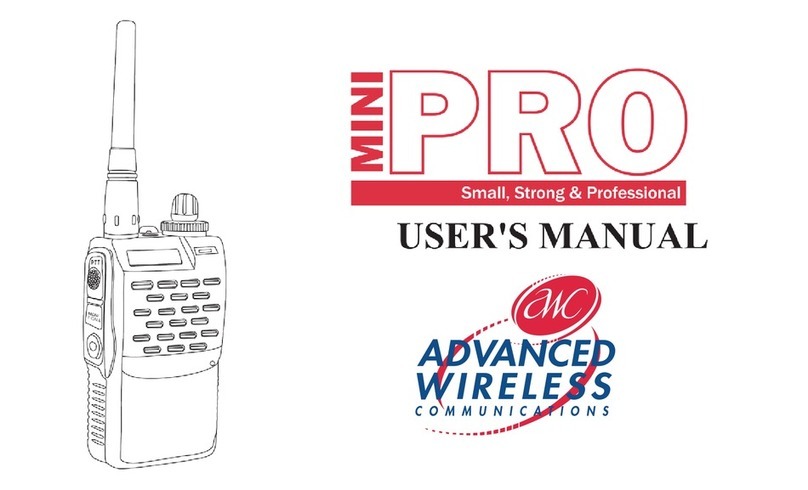
Advanced Wireless Communications
Advanced Wireless Communications MINI PRO user manual

PRESIDENT
PRESIDENT Truman 0341 owner's manual
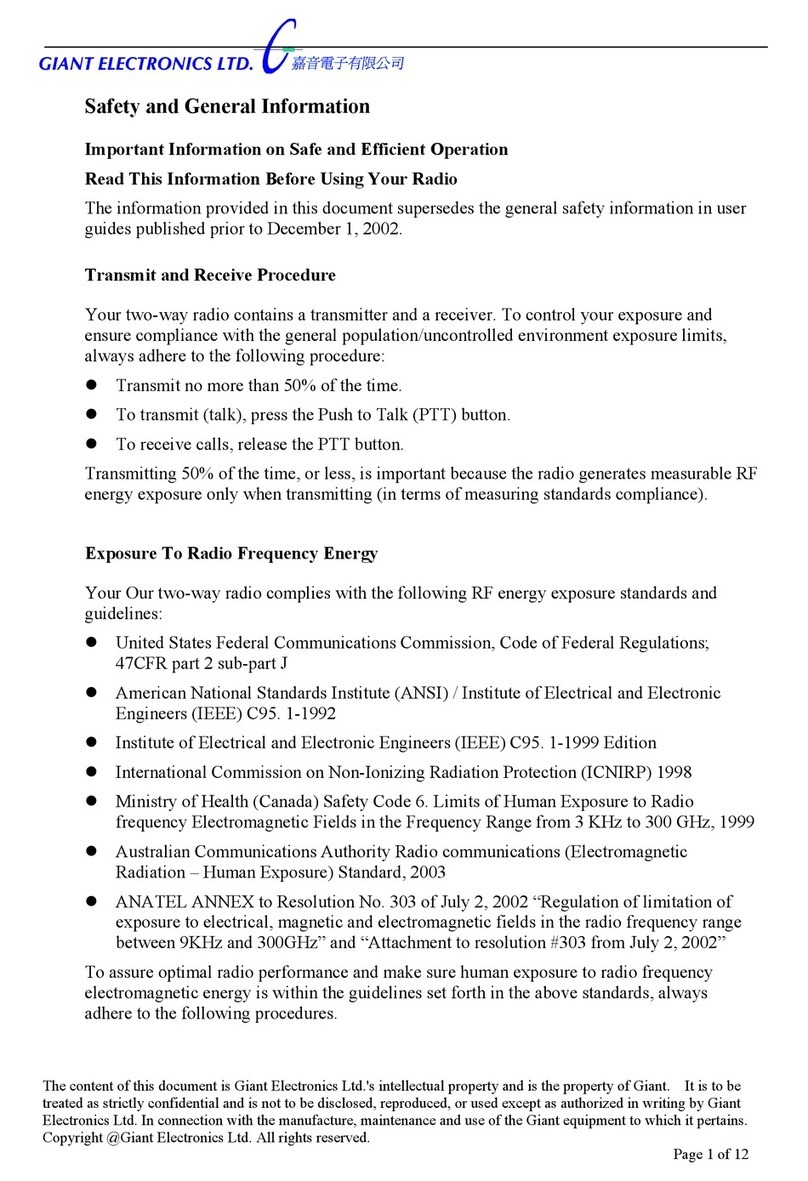
Giant Electronics
Giant Electronics T8220 manual
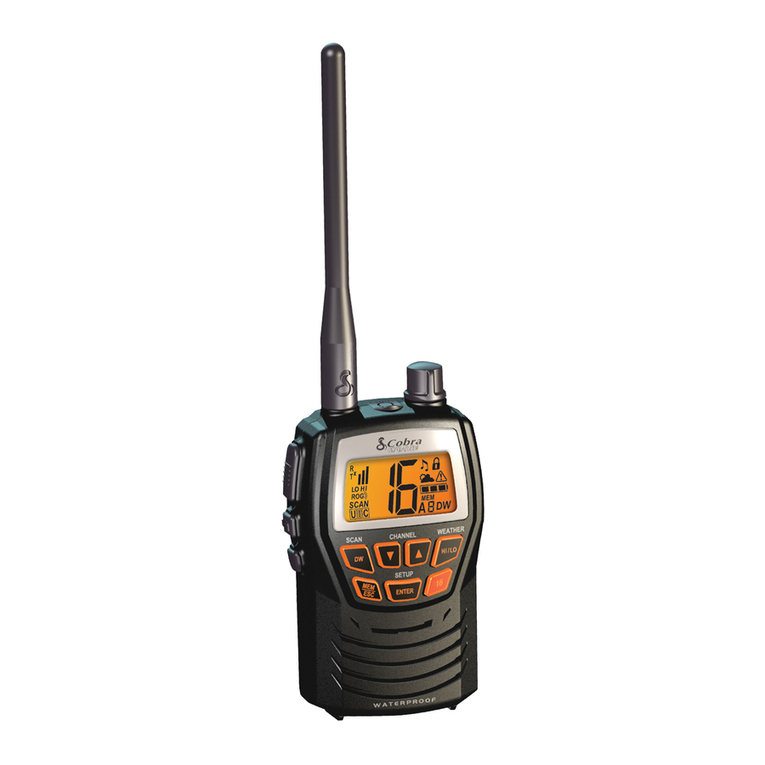
Cobra Marine
Cobra Marine Marine MR HH125 owner's manual
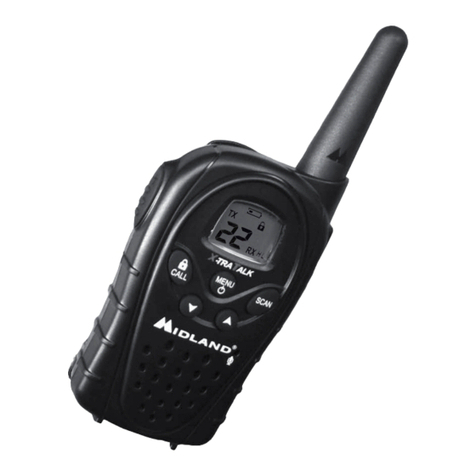
Midland
Midland LXT340 Series owner's manual
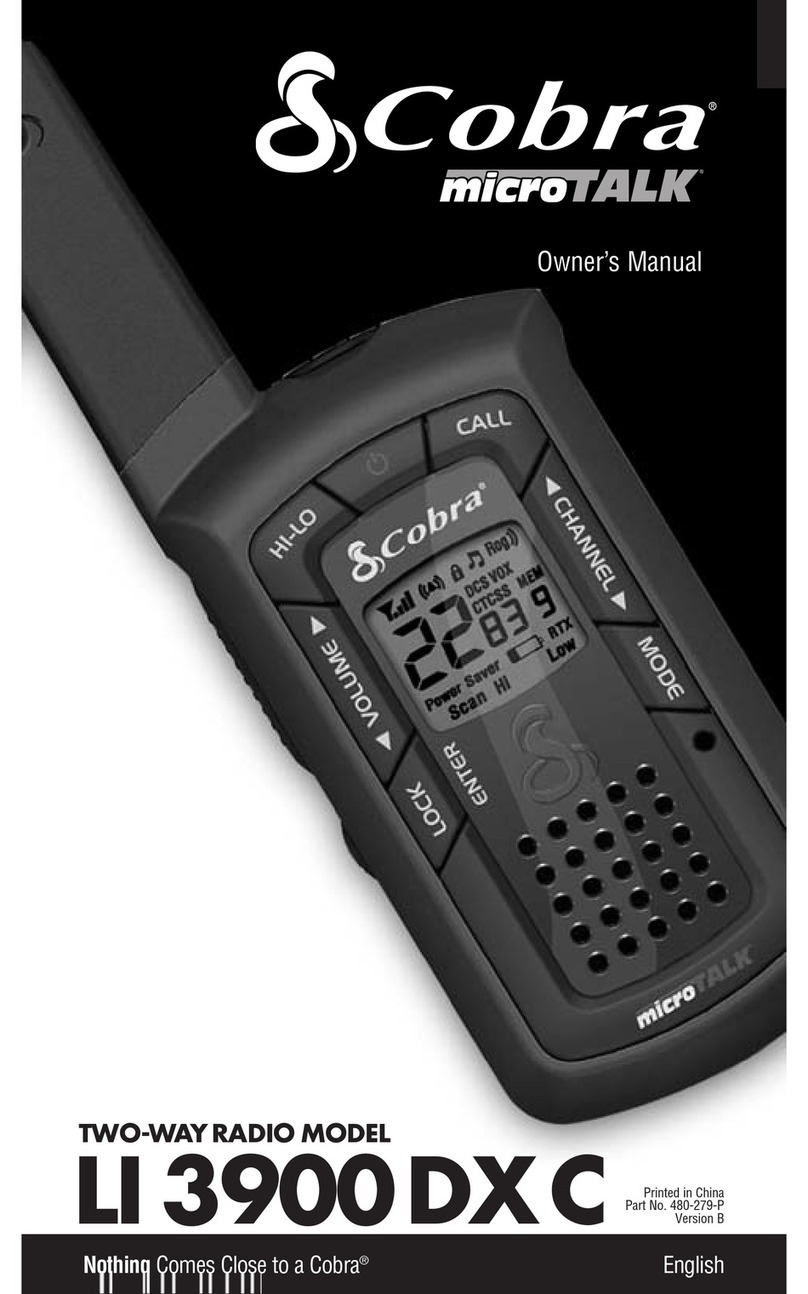
Cobra
Cobra LI 3900DXC owner's manual

